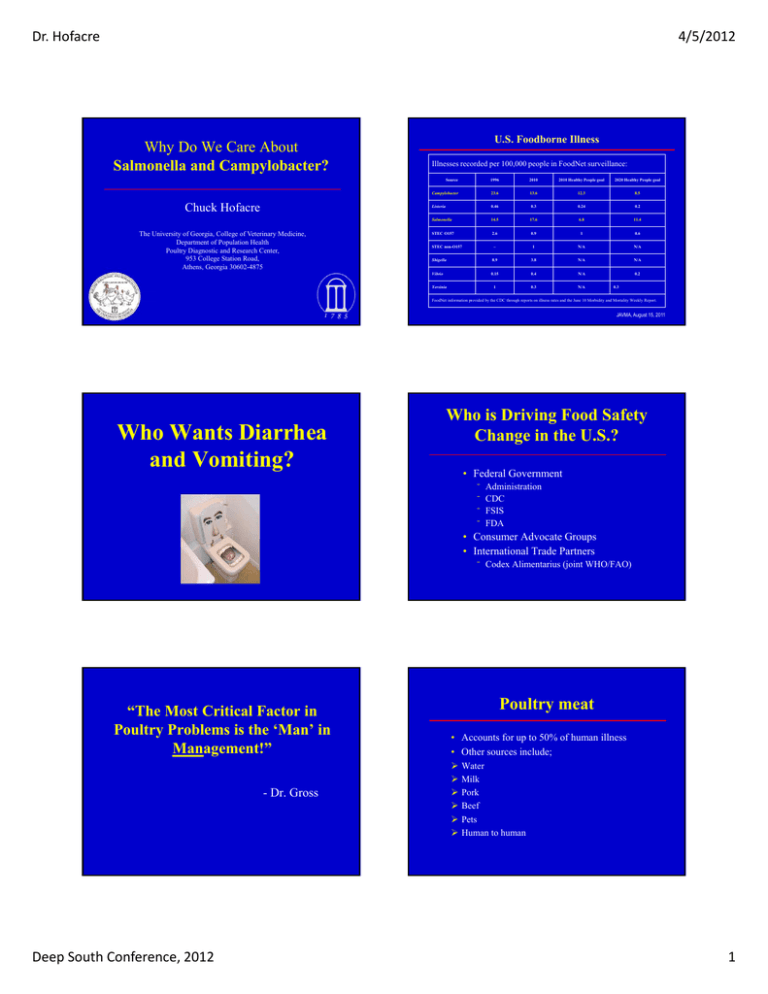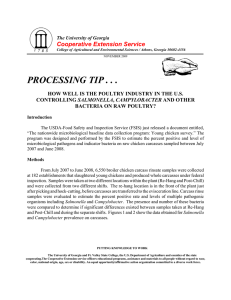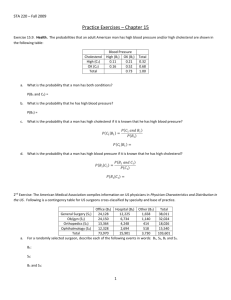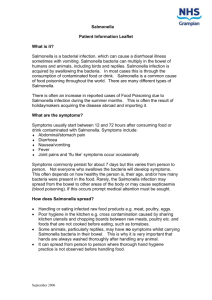Dr. Hofacre 4/5/2012 Why Do We Care About Salmonella and Campylobacter?
advertisement

Dr. Hofacre 4/5/2012 Why Do We Care About Salmonella and Campylobacter? Chuck Hofacre The University of Georgia, College of Veterinary Medicine, Department of Population Health Poultry Diagnostic and Research Center, 953 College Station Road, Athens, Georgia 30602-4875 U.S. Foodborne Illness Illnesses recorded per 100,000 people in FoodNet surveillance: Source 1996 2010 2010 Healthy People goal 2020 Healthy People goal Campylobacter 23.6 13.6 12.3 8.5 Listeria 0.46 0.3 0.24 0.2 Salmonella 14.5 17.6 6.8 11.4 STEC O157 2.6 0.9 1 0.6 – 1 N/A N/A Shigella 8.9 3.8 N/A N/A Vibrio 0.15 0.4 N/A 1 0.3 N/A STEC non-O157 Yersinia 0.2 0.3 FoodNet information provided by the CDC through reports on illness rates and the June 10 Morbidity and Mortality Weekly Report. JAVMA, August 15, 2011 Who Wants Diarrhea and Vomiting? Who is Driving Food Safety Change in the U.S.? • Federal Government ⁻ ⁻ ⁻ ⁻ Administration CDC FSIS FDA • Consumer Advocate Groups • International Trade Partners ⁻ Codex Alimentarius (joint WHO/FAO) “The Most Critical Factor in Poultry Problems is the ‘Man’ in Management!” - Dr. Gross Deep South Conference, 2012 Poultry meat • Accounts for up to 50% of human illness • Other sources include; Water Milk Pork Beef Pets Human to human 1 Dr. Hofacre 4/5/2012 Which Salmonella? New Campylobacter Standards 2007 2008 2009 S. enteritidis 16.9% 20.1% 19.2% S. typhimurim 16.0% 16.0% 16.1% S. newport 10.4% 10.1% 12.1% S. javiana 5.5% 6.3% 8.5% S. heidelberg 3.9% ---- 3.6% S. saintpaul ---- 6.0% 2.5% • No more than 8 positive samples in a 1 ml rinse • No more than 27 positive out of 51 (53%) samples in the 30 ml or 1 ml rinse * 2007 & 2009 CDC Foodnet Old U.S. Salmonella Standards for Broiler Chickens USDA Inspector in Charge (IIC) notified time to test 1. 2. 3. 4. One carcass/day selected, rinsed and mailed to USDA-FSIS lab Testing continues for 51 days (51 carcasses) 13 or more positive (>23.5%) means Failure 3 categories of plants with line speed incentives for lower Salmonella New Salmonella Standards • No more than 5/51 (10%) samples positive • 3 categories of plants with plants’ names posted on web for category 2 & 3 • Possibly S.E. testing?? Deep South Conference, 2012 USDA NPIP S.E. Monitored for Parent Breeders • Chicks from NPIP SE clean primary breeder • Drag swabs at 16-18 weeks and again at 40-45 weeks • All national data will be complied by USDA Campylobacter in Chickens • Chickens are usually culture positive after 3 wks of age • Flock exposure may be due to horizontal transmission from water or broiler house environment • Vertical transmission is possible but controversial 2 Dr. Hofacre 4/5/2012 Recent Campylobacter Research at UGA Epidemiology SPECIES • C. jejuni, C. coli positive breeders • C.jejuni more commonly present in younger flocks. • C.coli becomes more prevalent as birds get older, particularly breeders or organic. • Flocks will often be infected with both species (Waganaar et al.2008) • Hatch eggs at UGA • Broilers reared at UGA till 45 days of age • Never isolated any campylobacter by SEASONALITY • Prevalence significantly higher in summer to fall months (Jacobs-Reitsma et al.1994, van Asselt et al. 2008) • Human rates also seasonal, but precede poultry curve (Newell et al. 2000). Litter • Deep litter (re-used) – logical source of transmission. • However; In a study, Campylobacter was not isolated from experimental birds raised on litter obtained from a C.jejuni positive broiler flock.(Payne et al.1999). Darkling beetle • Persist long time in litter. • Implicated in vectoring other pathogens. • Camplyobacter was cultured from beetles in a positive broiler house (Bates et al.2004) • One study was unable to culture C.jejuni from beetles more than 72 hours after experimentally exposed. (Templeton et al.2006) • Chickens fed beetles which had been exposed to Campylobacter 7 days previously and were culture negative, became colonized (Hazeleger et al.2008) Campylobacter Risk Factors AUTHOR Bull Guerin Hansson McDowell Hue Russa COUNTRY UK Iceland Sweden N.Ireland France Holland Decreased Increased culture/filtration • PCR Negative On Farm Interventions for Campylobacter • Hermans et al.2011 – Review of effect of on farm interventions. Biosecurity can reduce the prevalence of colonized flocks, but must be properly applied, and is not sufficient alone. Drinking water treatments – limited effect Feed additives – contradictory data Competitive exclusion – contradictory data Vaccination – further work required – Salmonella vectored vaccine shows 6 log reduction(Wyszynska et al.2004) Prebiotics – limited potential observed Bacteriophages – potentially reduce load by 2 logs, further work needed, concerns over long term efficacy Bacteriocins – promising, more research needed Salmonella Control: Start at the top! RISK FACTOR Season ‐ Summer to fall Other livestock species on farm Storing litter on farm Spreading litter near house Increased Increased Increased Elites Decreased Increased Increasing flock size Increasing number of houses Increased Grandparents Increased Increased Increasing flock age Municipal or cholorinated water Changing footwear 2x before entering Changing disinfectant footbath regularly Decreased Parent Stock Decreased Decreased Increased Poor overall tidiness Rodents observed in or around house Thinning Poor flock health and welfare indicators GGP Increased Turkeys Broilers Layers Increased Increased Increased Increased Increased NO EFFECT Consumer Increased Deep South Conference, 2012 3 Dr. Hofacre 4/5/2012 Potential Sources of Salmonella Water Pest Management - Insects Feed Beetles Wildlife Insects Litter Rodents Hatchery/ Bird Move Fomites S.T. can live at least 60 days Humans Vehicles Alphatobius diaperinus What is a Major Source? Pest Management Insects - Flies • • • • Common house fly Egg to adult in 7 days Larvae need moisture Travel 1-3 miles to feed Musca domestica Pest Management • • • • Insects Rodents Wildlife Cats/Dogs Pest Management - Rodents Know how they live Water Feed Wildlife Insects Rodents Poultry House Litter Roof rat House mouse Hatchery/ Bird Move Fomites Humans • Depopulation best time for control • Location of baiting is determined by species Vehicles Norway rat Deep South Conference, 2012 4 Dr. Hofacre 4/5/2012 Bait Box Salmonella Isolates from June 2009 - May 2011 Live Vaccines • Will not make Salmonella positive chicks negative • Do not provide immunity to all serotypes • Will reduce fecal shed • Early protection almost like C.E. • Don’t prime for the killed Jun Jul Aug Sep Oct Nov Dec Jan Feb Mar Apr May Jun Jul Aug Sep Oct Nov Dec Jan Feb Mar Apr May 20 18 16 14 12 10 8 6 4 2 0 • Protects pullet about 30 days Kate Hayes, Aviagen, 2011 Drinking Water • Source of Salmonella?? • Method of spread Wildlife Insects Rodents Water Killed Vaccines? • Birds respond poorly to bacterial vaccines Feed Litter Poultry House Fomites Humans Hatchery/ Bird Move • Need 2 injections before lay • Will take 1 year to be effective Vehicles Flocks given chlorinated water at least once/week had significantly less Salmonella (Jones, 1991). What Controls Have I Tried? • Vaccination • Live • Inactivated • Water Treatment Deep South Conference, 2012 Bird Type Sample Liners NO-VAX 0.0% VAX 0.8% Pullets Environment 40.7% 40.6% 0.987 Feed 2.6% 8.0% 0.006 0.617 • Antibiotic Treatment • Competitive Exclusion • Combinations • Defined • Undefined Correlation Between Vaccination of Pullet Flocks and Salmonella Prevalence in Broiler Chicken Meat Birds for Two Poultry Integrators Breeder Broiler P Value 0.033 Total 17.2% 16.5% Environment 34.0% 35.4% 0.741 Ceca 57.9% 26.2% <0.001 Liners Environment 33.8% 30.5% 18.5% 15.1% <0.001 <0.001 Feed 5.6% 0.0% 0.246 Ceca 29.1% 17.0% <0.001 5 Dr. Hofacre 4/5/2012 Second Vaccination Study Manipulating Intestinal Flora 6 vaccinated • 12 breeder flocks 6 not vaccinated • 4 Drag swabs and 4 Boot socks at 35 and 45 weeks of age • 29 from vaccinated • 58 broiler flocks 29 from not vaccinated • 4 Drag swabs and 4 Boot socks 1 week before kill • Ceca at rehang Results 2nd Vaccination Study How Can We Alter the Normal Flora? • Undefined C.E. Breeders: • Defined C.E. / probiotic • No difference in Salmonella environmental samples or MPN per sample • Yeast or yeast cell wall (MOS) • Broilers: • • • • Antibiotics Vaccinated 14.1% positive Not vaccinated 25.5% Vaccinated 50% lower in ceca (MPN = 0.3 log 10 lower) • Organic Acids • Controlling intestinal disease, i.e. coccidia, Clostridium perfringens * Note – Boot socks again better than Drag Swabs Defined C.E. S. heidelberg Counts Comparison of Salmonella Cecal Culture Challenge Results After Final Culture 100% 12 100 b 100 86% 98% 90% 10 92% 83% Vaccinated Challenge 75% 60 58% NonVaccinated Challenge 40 Log 10 S. heidelberg counts 80 % o f P o s itiv e B ir ds 94% 92% Ceca (CFU) 80% Drag Swabs % 70% 8 60% 42 a 6 2x 50% 105 b 40% 4 30% 2 x 102 a 20 2 0 0 20% 10% S. hadar S. kentucky S. heidelberg S. enteritidis 0% C.E. Control C.E. Control 42 day old broilers * Bacillus subtilis Deep South Conference, 2012 6 Dr. Hofacre 4/5/2012 Organic acids in Drinking Water • • • • Used as food preservatives Spectrum of activity varies with carbon length Most of effect is in the crop - ↓pH Theory on function is modify gut flora by affecting what survives to colonize lower in the intestine (J. Dibner 2002, J. Appl. Poult. Res. 11:453) Cocci, N.E. and Salmonella Treatment Cecal Cocci Score N.E. Mortality (%) D.S. % + (42 day) Ceca % + (42 day) Negative Control 0.2 0 67 67 N.E. Positive Control 0.5 38 33 7 0 21 0 0 BMD 0.2 16 33 13 Roxarsone + BMD 0.1 12 0 0 Roxarsone Hofacre, 2007, J. Appl. Poult. Res. Prevention of Salmonella • No silver bullet • No magic potion • No single remedy Deep South Conference, 2012 7






